First, the snails are washed several times in running water, completely cleaned of dirt and mucus. For cleaning it is better to use a brush. In old recipes, it is recommended to cover the snails with salt to clear the mucus. Today, this is not always done, for reasons of humanity. And besides, salt greatly changes the taste of snails, and not for the better. So it's best to just wash them very thoroughly.
Washed snails are thrown into slightly boiling water, salted and blanched at a low boil for five to ten minutes. The snail houses will open. Then they are taken out, allowed to drain, quickly rinsed in running cold water. Then they are taken out of the house (it is better to do this with a bacon needle) and the gastric tract is separated at the end of the snail, the head is cut off.
The snails are again placed in a shallow flat saucepan into which water and white wine are poured in a ratio of 1:1. It is recommended to put in a saucepan per liter of liquid: 1 medium-sized carrot, 1 onion, 2 shallots - all cut into circles and rings, and one bunch of greens: 10 sprigs of parsley, a sprig of thyme, parsley leaf, a pinch of black pepper and 8 g of salt. Water with snails should boil, the foam must be removed, boil them on a low heat for 3 hours. Then pour into a shallow dish and leave the snails to cool directly in the broth.
Then the snails, depending on the recipe, will either be put back into the houses, or a stew will be cooked from them. If houses are used, they must be washed very well and then boiled in in large numbers water, you can add a little soda to the water. The houses are then allowed to drain, rinsed and dried. Such recommendations are given, for example, by the famous French chef Bocuse.
A textbook edited by Pauli (for cooks in Switzerland, Austria and Germany) advises after ten minutes of boiling to remove the mucus, rub the snails many times with coarse salt and put them on melting ice. Some German books advise using salt and flour for cleaning. And then the snail, already without a head and a stomach, is stewed for about three hours in shallots and garlic, in a mixture of white wine and concentrated veal broth. It, in some German recipes, can be replaced with beef. But use meat broth not typical for all recipes.
Classic snail dishes
French snails.
Two regions of France are famous for snails: Burgundy and Alsace, and therefore the two main recipes are Burgundy snails and Alsatian snails. The essence of all these recipes is that the prepared snails are put back into the house, it is covered with butter with shallots and herbs, and baked. And served hot, with white bread that is dipped in hot butter with herbs.
Interestingly, the sweet Crimean onion is also a shallot.
Although almost every French region has its own recipes, snails in Provencal, Strasbourg, Dijon are very famous. They are cooked in truffle oil, in anchovy oil with nuts, in parmesan oil. Most often, Chablis is served with snails - this is Pinot blanc with natural gassing of wine. But any white young and uncomplicated wines go well with snails, they are different in each region. You do not need to use expensive wines for their preparation.

Snails in Burgundy (escargots a la bourguignonne)
Components for 8 people:
48 house snails prepared as above
10g garlic
30g shallots,
20g parsley,
2g ground black pepper
250g butter,
Breadcrumbs from white bread.
Cooking
Finely crush the garlic, chop shallots and parsley very finely, mix everything with salt and pepper and mash with butter.
Put a snail into each house and cover it with a piece of butter the size of a hazelnut. Press a piece of butter deeply into the house. Lubricate the shell houses with the rest of the oil. Grease a plate with special recesses for baking shells or just a baking dish with a little water, lay out the shells, sprinkle them a little breadcrumbs and bake in the oven for 8 minutes. The oven temperature during baking is 200-220 0 C, the butter should boil slightly and foam. Serve hot. This is a classic recipe from Bocuse.
Pauli's tutorial gives a slightly different recipe for snail oil. For 120 snails, or 10 servings: 300g butter, 40g shallots, 15g garlic, 30g parsley, salt and pepper to taste, and extra 5g thyme, 5g marjoram, 15g ml. cognac and 100 ml. not too cold cream.
In the cooking variant of Chablis (escargots a la mode de chablis) snail oil is not used, and the shell is closed with chopped shallots, you need about half a teaspoon per shell and the snails are stewed in white wine.
Alsatian snails (escargots a l alsacienne)
The preliminary preparation of the snails is the same as in the Burgundy snails, but the snails themselves are prepared differently. When they are washed, blanched and freed from the intestines, they are boiled completely a small amount liquid that barely covers them. A fresh piece is put into this liquid for snails. pork skin both a piece of veal shank and snails are boiled in a very concentrated and saturated gelatin broth. And when the snails are put into the shell, they leave a little jelly in it. Then they are covered with butter, and when baking, a little broth is added and also sprinkled with breading and baked.

Swiss snails
The Swiss cook snails without houses. Neuburg snails (Jacquerie neuchateloise) prepared as follows: already prepared snails are heated in butter and white wine, spread on top sauerkraut, add snail oil and bake in a salamander. Salamander is a special device that gives a baked crust on the surface. Sometimes it works out well to bake on the top baking sheet of the oven or under the spiral of the microwave. They are served with boiled potatoes.
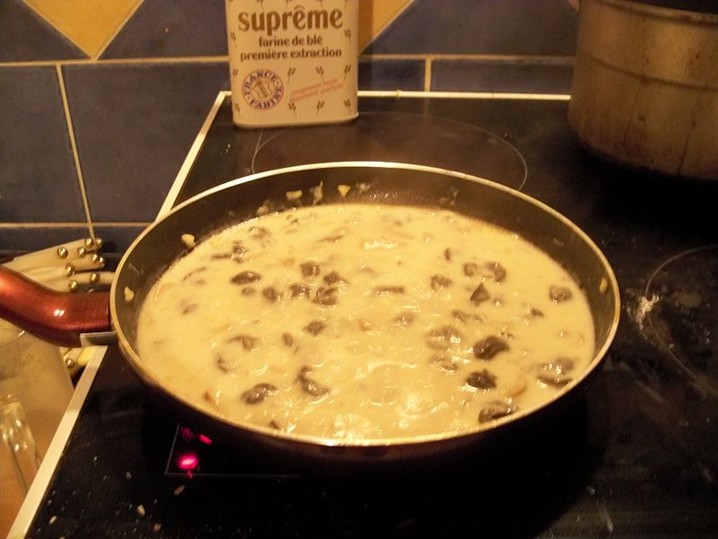
Snails in rieslig (escargots au riesling) prepared like this: first they are stewed in Riesling, then napping Riesling sauce and heavy cream, put pieces of snail oil in the sauce and glaze in a salamander. Napping- pouring and saturation with sauce.
german snails
V German cuisine snails were eaten by the poor in Baden and Upper Swabia, but cooked a little more simply. They simply destroyed the membrane, washed it very well and covered the snails with a mixture of salt, vinegar and flour for several days. Then they simply blanched for five minutes in boiling water, separated the stomach and dark back, rubbed with salt and stewed in a mixture of white wine and beef broth or water, adding roots and herbs that were at hand. When later the aristocracy began to imitate haute cuisine, they began to keep the houses, boil them with soda and put snails in them. There is even a mocking expression of the peasants which translates as "our pastor eats snails." Collected snails naturally in the winter in the vineyard. They were just dug out from under the snow. Germans often add snails to salads.
But the classic of Baden cuisine is Baden soup with snails (Badische Schneckensuppe)

Components
24 prepared snails or canned snails
4 shallots,
40g butter,
250ml dry white wine
1 liter of meat broth, preferably veal,
20g carrots, celery and leeks, chopped
a pinch of salt,
250g cream
2 yolks,
2 tablespoons chopped parsley.
Cooking
Finely chop the shallots, finely chop half of the snails and stew with onions in butter. Salt, pour wine and meat broth, boil. Add the rest of the snails, straws and simmer for ten minutes until the roots are soft. At the end, mix the yolks and cream and pour into the soup that has almost stopped boiling, sprinkle with parsley.
Austrian snails
In 1858, the famous cookbook by Katharina Prato was published. This book was reprinted 79 times until 1960. In it, as dishes for fasting, there are six recipes for snails. There are many recipes in high Viennese cuisine. The Austrians, for example, fry snail halves in butter, adding bone marrow.
And of course they do (Wiener Schneckengulasch)
Components
200g prepared snails
2 onions, chopped small cubes,
a little olive oil
garlic clove (thin slices)
125ml paprikamus: finely ground eggplant caviar with red peppers
1 tablespoon sweet paprika
250ml beef broth
1 tablespoon of tomato paste,
a little finely ground marjoram, thyme, rosemary and cumin, salt and black pepper.
Cooking
V vegetable oil fry onion and garlic, add paprikamus and tomato paste and put out. Pour in the broth, add salt and spices, leave for 10-15 minutes over low heat. Add snails, boil again and leave to brew.
Other recipes with snails
Many recipes for snails have been preserved in Italian cuisine, especially in the north of Thalia. They are cooked with cheeses and bacon, in lemon sauce. The Spaniards make tapas and paella from snails. Many new recipes with snails are also created by modern chefs.
In 2005, the Austrian publishing house Stocker published a book in German called "Schneckenkochbuch" (Cookbook of snails), ISBN-10: 3702010939. The book has 245 pages and great amount recipes!
Bon Appetit! 🙂
Grape snails are associated with an aquarium or with a summer house, the sea, but certainly not with cooking. Meanwhile, snail dishes are very useful for the human body, and almost all over the world they have already won love.
The process of making grape snails came to us from french cuisine. The dish is considered exotic and has a refined taste.
In order to cook a grape snail at home, you can buy ready-made marinated or frozen snails in a store or market. But for some recipes, canned snails will not work, but you will need to grow your own or buy live ones.
Cooking snails is a rather complicated process, but interesting. If you decide to completely cook the snails yourself, then you need to be a non-squeamish person.
The recipe for making grape snails is quite ancient. In Europe and Asia, for example, snails are generally a familiar and common item on the menu of almost all restaurants, while for us, for now, grape snails are a curiosity. But more and more restaurants are already striving to pamper a Russian citizen with such an exotic and exquisite dish. The most common in Russia and around the world is the recipe for cooking snails in French, which we will consider below. The French also call it escargot. Mine unusual taste it acquires due to the fact that the shells are filled with garlic sauce with the addition of butter, due to which the snails acquire a special delicate taste.
In general, there are a lot of recipes for cooking snails, for different tastes. Snails can be marinated. To do this, they are boiled and then added to a mixture of soy sauce and wine. Also, snails can be cooked with various sauces:, cottage cheese. In addition, snail salad and roast fried and boiled snails, or baked snails will be very tasty and unusual.
Recipes and dishes of various nations are firmly included in our cuisine. And we adjust them for ourselves, adding something, and removing something. Thus, preparing and bringing the snails closer to our usual taste.
Below we will consider the preparation of canned grape snails.
Grape snails - recipe
Ingredients:
- canned grape snails - 1 kg;
- fresh baguette - 1 pc.;
- butter - 300 gr.;
- garlic - 1 head;
- lemon juice;
- parsley, herbs, salt - to taste.
Cooking
We take out the snails from the shells, remove all the insides. Next, fry the meat in a pan. In empty and dried shells 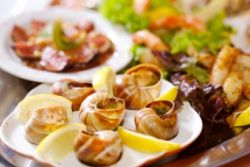 snails add fried meat. Then we take the butter, cut it into pieces, add the squeezed garlic, lemon juice and herbs. All this salt, pepper and grind with a blender. Add the resulting mixture to the shells. Next, preheat the oven and put our snails on a baking sheet so that they all lie butter side up. In the oven, they cook for about 2-3 minutes.
snails add fried meat. Then we take the butter, cut it into pieces, add the squeezed garlic, lemon juice and herbs. All this salt, pepper and grind with a blender. Add the resulting mixture to the shells. Next, preheat the oven and put our snails on a baking sheet so that they all lie butter side up. In the oven, they cook for about 2-3 minutes.
Cut the baguette into thin slices and remove the finished snails from the oven.
Can be served at the table. We take out the meat with a toothpick, eat it, and eat it with bread.
The words grape snail the modern urban dweller is more likely to associate with aquariums than with cooking. However, in many European and Asian countries, snails are a common item on restaurant menus. Grape snails are farmed and sold live or frozen and ready to eat. Even snail caviar is used for food, resembling noble mushrooms in taste.
Grape snail only in the XX century began to be considered a delicacy. For thousands of years, snails, like other shellfish, have been a common food for the inhabitants of the coastal regions of Europe. From early spring to late autumn, snails were collected on beaches, in gardens, and in vineyards. They were a salvation for the poor and a delicacy for the nobility. Today, grape snails can be found not only on the warm European shores, but also in Ukraine, Belarus, and the central regions of Russia. In the countries of the Mediterranean, helitseculture is well developed - the cultivation of edible snails on special farms. In Russia, snails are bred only in the Kaliningrad region.
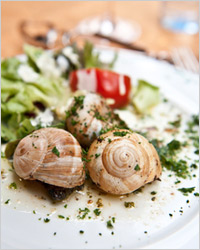 If you have doubts whether it is worth eating snails at all, we will answer: everyone is free to make their choice. Someone treats these cute creatures as pets, but for someone it is valuable. protein product With amazing taste and many useful features.
If you have doubts whether it is worth eating snails at all, we will answer: everyone is free to make their choice. Someone treats these cute creatures as pets, but for someone it is valuable. protein product With amazing taste and many useful features.
As for the usefulness of snail meat, there can be no doubt: only 90 calories per 100 g; only 2-3% fat, and that consists of unsaturated and polyunsaturated fatty acids, no cholesterol and as much as 15% protein. Snail meat is rich in magnesium, phosphorus, potassium, calcium, iron, zinc, copper, vitamins A, E and group B. It is not surprising that snails are considered a powerful aphrodisiac, comparable only to oysters.
"Culinary Eden" figured out how to cook snails, and shares with readers the best recipes. There are two main directions in dealing with snails collected in the wild: you can cook snails very simply: bake or cook on a fire, or you can devote a few days to them and get a real product culinary arts- escargo.
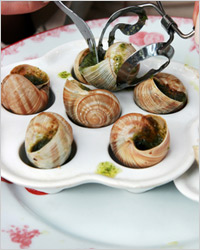 Let's start with a simple one: how to cook snails in a quick way. This information will be especially useful for tourists who, in the event of a sudden encounter with snails, will be able to diversify their meager diet. It happens that for some reason, snails begin a mass migration and crawl out onto the roads in hundreds. With a successful combination of circumstances, in half an hour you can gain several kilograms of snails, and after another 10-15 minutes you can get a tasty and hearty lunch. To do this, lay the snails in the shells with the holes up on the grate over the coals, salt, pepper, pour a little oil into the holes or put a piece of lard. Bake the snails for about 10 minutes. Pick out the finished snails with a toothpick and separate the meat from the insides.
Let's start with a simple one: how to cook snails in a quick way. This information will be especially useful for tourists who, in the event of a sudden encounter with snails, will be able to diversify their meager diet. It happens that for some reason, snails begin a mass migration and crawl out onto the roads in hundreds. With a successful combination of circumstances, in half an hour you can gain several kilograms of snails, and after another 10-15 minutes you can get a tasty and hearty lunch. To do this, lay the snails in the shells with the holes up on the grate over the coals, salt, pepper, pour a little oil into the holes or put a piece of lard. Bake the snails for about 10 minutes. Pick out the finished snails with a toothpick and separate the meat from the insides.
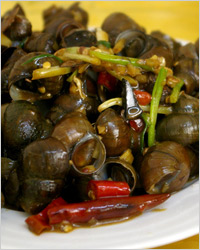 There is a more humane, tastier and cleaner way to cook snails in field conditions. To do this, you need to prepare several liters of boiling water. We lower the snails into boiling water and cook for a very short time - 3-5 minutes after boiling again. The purpose of this procedure is to quickly clear the mucus from the snails and facilitate their removal from the shells. The extracted snails should be butchered, leaving only the fleshy "cephalopod". Next, we act according to the circumstances. You can continue cooking snails in fresh salted boiling water with vegetables and get full soup, or you can fry the snails in lard or vegetable oil along with onions and garlic - you get delicious snack tastes like mushrooms and white meat.
There is a more humane, tastier and cleaner way to cook snails in field conditions. To do this, you need to prepare several liters of boiling water. We lower the snails into boiling water and cook for a very short time - 3-5 minutes after boiling again. The purpose of this procedure is to quickly clear the mucus from the snails and facilitate their removal from the shells. The extracted snails should be butchered, leaving only the fleshy "cephalopod". Next, we act according to the circumstances. You can continue cooking snails in fresh salted boiling water with vegetables and get full soup, or you can fry the snails in lard or vegetable oil along with onions and garlic - you get delicious snack tastes like mushrooms and white meat.
If you have the time, kitchen and a full set of utensils, there are several ways to prepare a delicacy from wild grape snails.
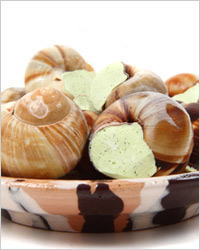 First, the snails should be aged to clean their innards and then not mess with butchering. Someone recommends keeping snails in the refrigerator in an empty pan without food for 3 to 14 days and rinsing periodically. Other chefs advise planting snails for several days on flour, bran and aromatic herbs - thyme, fennel. With this method, already on the 3rd day, the snails will be cleaned and acquire a natural aromatization. By the way, in the Mediterranean countries, snails are especially tasty, as they feed on aromatic herbs in vivo. Live snails bought in the markets of Crete, Cyprus, Greece and other European countries do not need to be cleaned - they have already been prepared for use on farms. Unfortunately, the meat of snails collected in the Crimea and Russia, without prior cleaning, greatly loses its taste.
First, the snails should be aged to clean their innards and then not mess with butchering. Someone recommends keeping snails in the refrigerator in an empty pan without food for 3 to 14 days and rinsing periodically. Other chefs advise planting snails for several days on flour, bran and aromatic herbs - thyme, fennel. With this method, already on the 3rd day, the snails will be cleaned and acquire a natural aromatization. By the way, in the Mediterranean countries, snails are especially tasty, as they feed on aromatic herbs in vivo. Live snails bought in the markets of Crete, Cyprus, Greece and other European countries do not need to be cleaned - they have already been prepared for use on farms. Unfortunately, the meat of snails collected in the Crimea and Russia, without prior cleaning, greatly loses its taste.
Having completed the cleaning of the snails (or having bought live prepared ones), you need to make sure that there are no dead ones among them. To do this, place the snails in water and remove those that show no signs of life. Next, boil the snails in boiling water along with the shells, rinse - and they are ready for culinary experiments.
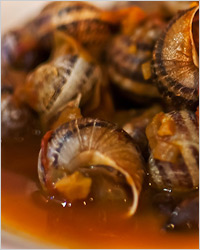
Ingredients:
1 glass of dry red wine
fresh mint, basil, marjoram,
salt, pepper to taste.
Cooking:
Snails in shells quickly fry in olive oil, pour wine, salt, pepper and simmer over low heat for 10-15 minutes. Shortly before readiness, add chopped greens. Serve the snails in their shells, drizzling with the remaining sauce. Ale can be used instead of wine.
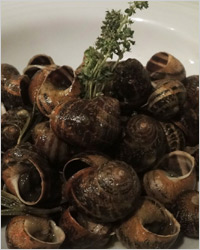
Ingredients:
500 g prepared blanched snails,
100 ml olive oil,
2 tbsp wine vinegar,
1 tbsp rosemary,
salt to taste.
Cooking:
Heat a frying pan, sprinkle a thin layer of salt on it and place the snails on it with the hole down. When the snails are dry, pour the oil into the pan, stir and leave the pan over medium heat for 3-5 minutes. Add rosemary, vinegar, stir and remove from heat. Serve the snails in their shells, drizzling with the oil they were fried in. Pull the flesh of the snails with a toothpick and remove the dark tip. The rest of the insides can not be removed.
Most gourmet dish from grape snails - escargot. For its preparation and serving, they even came up with special devices: an escargot (a metal tray with recesses for shells), tongs to hold the shell, and a fork with two long prongs to take out the contents. In France, escargot is usually served as an appetizer before dinner, while in the US and Australia, this dish is considered the main dish and does not need additions.
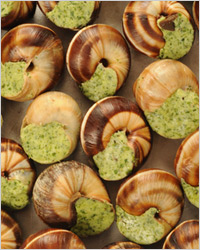
Ingredients:
1 kg prepared snails
300 g butter,
1 large head of garlic,
lemon juice, parsley, salt, pepper to taste
hard cheese optional.
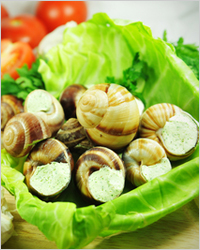 Cooking:
Cooking:
Blanch the snails for 2 minutes, remove from the shells, remove the insides. Snail meat lightly salt and fry (or boil in new water with onions and herbs). cook flavored oil: mix finely chopped garlic and chopped parsley with softened butter, add lemon juice, salt and pepper. In empty dried shells, put a piece of snail meat and fill to the top with oil. Top with grated cheese. (Escargots can be frozen at this stage and stored in the refrigerator for several weeks. In France, these are the prepared frozen escargots sold in supermarkets.)
If you don't want to use the shells, put the flavored butter in a baking dish and top with the snail meat. Place the container with the snails in the preheated oven for 10 minutes (or in the microwave for 2-3 minutes) and serve immediately. Escargots in shells are eaten with special forks or toothpicks. Dry white, red or rose wine is served with this dish.
If cooking live snails does not fit into your picture of the world, but french delicacy if you want, try to find frozen snails. They are sold in many large supermarkets already peeled and boiled. You can also use canned snails, but their taste will be noticeably worse.
With frozen snails in shells, you can do very simply: put on a baking sheet, sprinkled with salt for stability, season with your favorite spices and bake for 5-10 minutes at a temperature of 200-230ºС. And you can conjure a little, for example, like this:
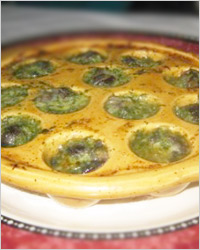
Ingredients:
20-30 pcs. frozen or canned snails without shells,
100 g butter,
50 g parmesan,
2-3 garlic cloves,
Parsley, nutmeg, salt to taste.
Cooking:
Mix softened butter with chopped parsley, garlic, nutmeg and salt. Spread the snails in an escargot dish (you can use small baking tins), put a little butter on top, sprinkle with grated cheese. Bake snails for 10 minutes at 230ºС. Serve with baguettes and dry wine.
With skillful handling, the grape snail willingly turns into delicious dish. Experiment more boldly!
Grape snails are among the most spectacular and delicious delicacies of animal origin. Thanks to this, shellfish dishes can be found on the menu of most restaurants in the world, from French to Russian. In addition, a grape snail can also be cooked at home and for this it is not even necessary to buy a delicacy in a store.
A few words about grape snails
Common snails are most often found in countries of the temperate zone, so there are a lot of them in the south of Russia. You can cook both grape and garden clams.
The difference between the species is only in size, so it is preferable to collect grapes. In addition, the latter are grown on special farms for gastronomic purposes, because the meat of these animals is considered not only tasty, but also very healthy.
It has been proven that snail meat contains about 10% more protein than, for example, chicken meat. In addition, the delicacy is rich in useful elements such as magnesium, iron, calcium and even B vitamins.
Where can you get a delicacy? In nature, animals that are not very pleasant in appearance, but excellent in taste, settle in degrading forests, as well as fields. In addition, they can often be found in gardens where the soil is limestone. If you are going to look for gastropods in dry weather, most likely they will hide under stones or just in shady places.
How can you cook a grape snail at home? Of course, the Russians do not eat tons of this delicacy, like some French, but sometimes you still want to pamper your guests with some unusual goodies. And dishes from clam meat are ideal for these purposes.
However, it should be understood that before preparing an unusual dish, the meat should be processed in a certain way, otherwise the taste of the dish will turn out to be frankly useless.
How to clean?
So, we have already figured out that you can catch clams even in own garden. At the same time, "hunting" is best done either in the early morning or after rain. It is at these moments that the chances of catching gastropods increase many times over.
After you get a live delicacy, you will have to perform a very unpleasant, but necessary procedure for cleaning animals from mucus and dirt.
For this you need:
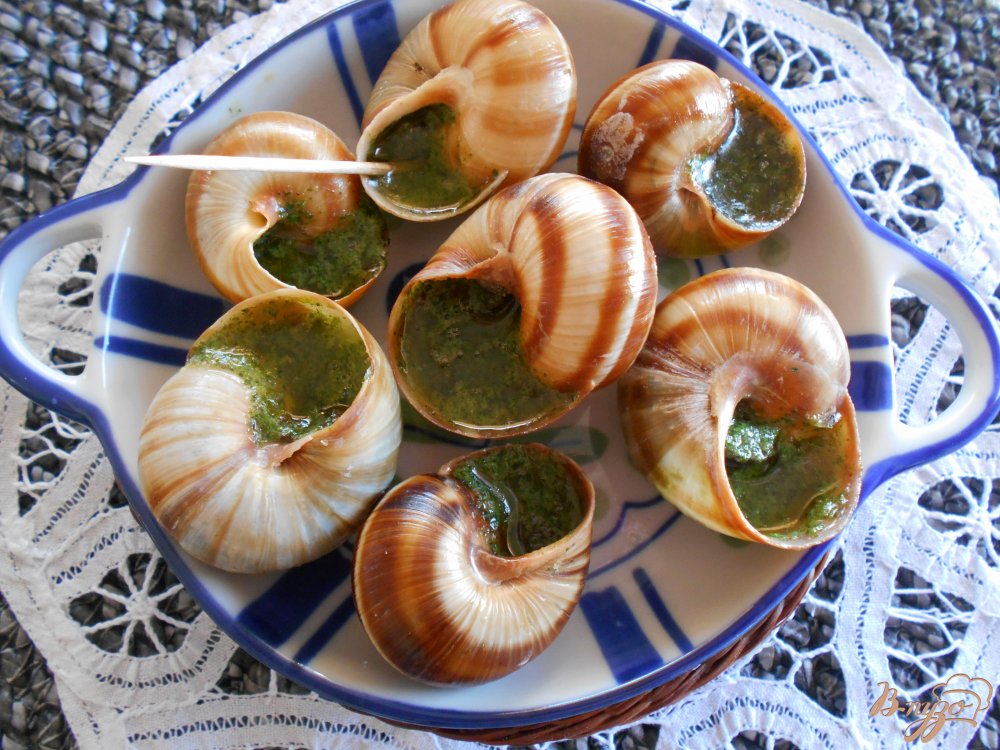
- Take a large container and pour flour on the bottom (0.5 kg of product will require 2 tablespoons of flour);
- Put the “gastropods” there for a day;
- On the second day, the mollusks also need to be “feeded” with flour, but now it will take half as much;
- On the third day, the animals are generally satisfied with a fasting day and are not given flour at all;
- Then they are washed with running water several times to clear them of mucus;
- After that, the delicacy is poured into a container, at the bottom of which there is a small layer of salt;
- Since the "leg" is very sensitive, the animal will begin to secrete mucus profusely and die in a couple of hours;
- Next, the clams are washed again, after which you can proceed to the next stages of cooking.
Russian snail recipe
How to cook grape snails at home? Despite the apparent laboriousness of the process, cooking meat is quite easy. Consider one of the options using the example of this recipe.
To prepare the dish you will need:
- 1 kg of shellfish;
- 2 tbsp. l. white wine;
- 5 st. l. olive oil;
- 300 g butter;
- Parsley;
- Salt and pepper to taste.
Preparing the mild sauce:
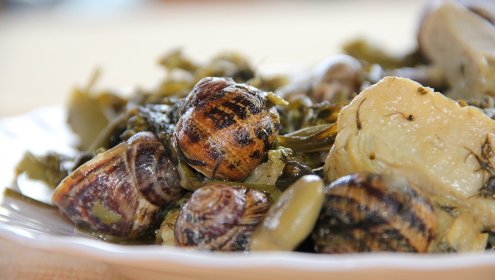
- First of all, a sauce is prepared from olive oil and butter, heated in a pan;
- After three minutes, pour 2 tbsp into the pan. l. white wine;
- Then add salt and pepper to taste and after about 5-7 minus the sauce is removed from the heat;
- After the sauce has cooled, finely chopped parsley is added to it.
Meal preparation:
- To make clams skewers, rinse them as described above;
- Pepper and salt the delicacy;
- Place the shells, holes up, on the grill;
- Start frying the clams;
- When red liquid starts to “shoot out” from the sinks, remove the grate.
The whole cooking process delicious kebabs"should take no more than 10-15 minutes, but the result will exceed all expectations.
Snails "Napoleon"
The recipe with boiled gourmet meat will definitely appeal to gourmets, as the dish turns out to be really tasty, and the meat melts in your mouth.
In addition, for the preparation of Napoleon, you will need very few ingredients, namely:
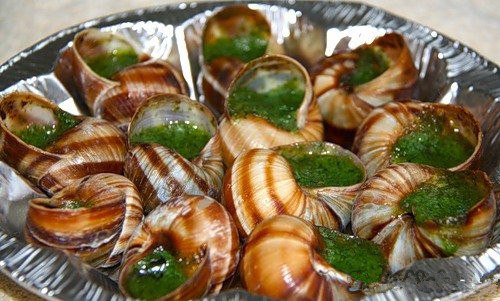
- 25 pcs. grape jellyfish;
- 1 glass of white wine;
- 500 ml vegetable broth;
- 7-8 pcs. almonds;
- Salt and pepper to taste;
- 50 g of mushrooms (champignons);
- 2 tbsp. l. tomato sauce;
- 100 g butter.
Cooking process:
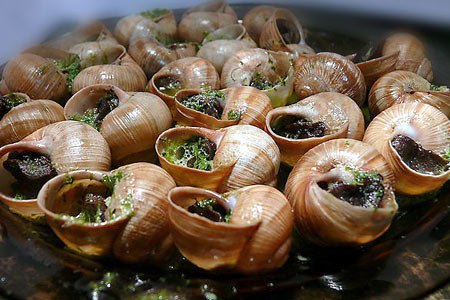
- To cook the clams according to this recipe, fill them with cold water;
- Bring contents to a boil;
- After the water boils, put the delicacy in a colander and cool;
- Then remove the mollusk from each shell and rid it of the “horns” and the “black stripe” on the abdomen;
- Pour the cleaned meat vegetable broth and simmer for at least 3 hours;
- Chop the almonds into small pieces;
- Then fry the mushroom pieces in butter;
- Pour almonds into the pan and add salt and pepper to the contents;
- Lubricate all molds with butter;
- Lay a mushroom pillow at the bottom of the molds, then lay out 2-3 carcasses;
- Fill in the content tomato sauce;
- Bake the dish in the oven for approximately 10 minutes.
Snail meat cooked in the oven is very fragrant and tender. In addition, outwardly, the dish comes out very appetizing and attractive, so you can safely decorate even a festive table with it.
snail gratin
This dish can be prepared not only with porcini mushrooms, but even with chanterelles or honey mushrooms. In addition, the recipe does not exclude the possibility of using dried mushrooms, which will only need to be soaked before cooking.
You will also need the following ingredients:
- 5 kg boiled snails;
- 1 onion;
- 150 g mushrooms;
- 200 g butter;
- 150 g cream;
- Greenery;
- Salt and pepper to taste.
Cooking process:
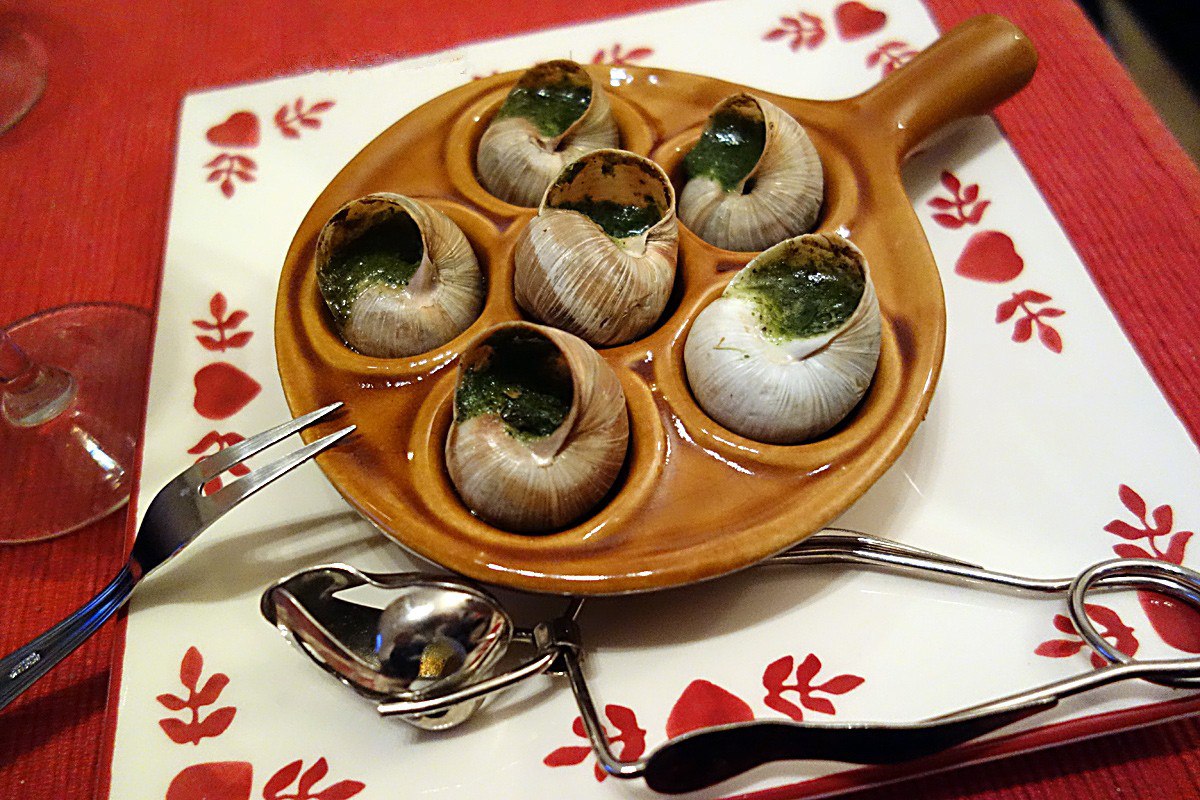
- Heat the pan and fry the finely chopped onion on it;
- After a couple of minutes, add chopped mushrooms to the pan;
- Fry the contents for about 15-20 minutes over medium heat;
- Then add 150 g of cream to the vegetables;
- After a couple of minutes, remove the pan from the heat;
- Pour the fried vegetables into a blender, then salt and pepper;
- Grind the mushrooms and onions in a blender, turning the vegetables into a paste;
- After that, lay out the delicacy meat in portioned dishes, and put the chopped vegetable mixture on top;
- Send the dish to the oven for 5-7 minutes.
How to eat a snail?
Often there are recipes in which meat cooked directly in the shells is served at the table. In such a situation, you can extract the delicacy from the spiral using special cutlery, such as a fork with two long teeth and table tweezers. As a rule, shellfish dishes are washed down with dry white wine.
Grape shellfish dishes are a real delicacy that everyone can afford. To cook a delicious and fragrant dish, it is not necessary to stand at the stove for a long time.
As a rule, it takes no more than half an hour to cook dishes with shellfish, but not only hostesses, but also guests who have tasted an unusual but tasty treat are satisfied with the result.
Having read once again that Latvia has a "good harvest of snails" this year,
I thought -Why aren't we French? And in general, they are eaten in many countries!
I studied everything about them and compiled a selection for you.
Read, cook and "enjoy the unique taste" as the saying goes:
A good article about snails with pictures (so as not to be confused with anyone!) - PRESS!
In many countries meat snails is considered not only an exquisite and tasty delicacy, but also medicinal (especially for men's health). They began to use them in ancient Rome and, fortunately, this glorious tradition has survived to this day.
The ancient Romans attributed the following medicinal properties to snails. properties: the ability to stop bleeding, treat gastrointestinal disorders, heal wounds, etc. Meat is especially indicated snails those who need to restore the calcium balance in the body, as well as those who suffer from collagenosis and chondrosis. snails well normalize the metabolic balance in the body, has a calming effect on nervous system and normalizes bowel function. Only a few types of snails are eaten. For instance: snails grape, Burgundy snail, Roman, etc. They grow quite slowly and individuals that have reached 2-3 years of age can be eaten. : Here I will collect recipes for cooking snails. I’m unlikely to be able to eat them myself (most likely - I won’t drink as much as in that joke), but note to gourmets ... Preparation of grape snails. Since ancient times, snail meat has been considered dietary product. It is much better absorbed by the body and does not cause heaviness in the stomach. One of the most common snail recipes is grape snails in garlic sauce. Ingredients: meat snails- 100 gr, lemon - 1 pc, butter - 100 gr, 3 cloves of garlic, parsley, vegetable oil, salt and black pepper - to taste. Preparation: thawed grapes snails fry in a hot frying pan in oil with salt. Cook in a separate bowl garlic Sause: Mix finely grated garlic with butter, lemon juice, salt, pepper and finely chopped parsley. Put garlic oil into portioned forms, put one snail on top and bake the dish in the oven for 3-5 minutes. The oven should be preheated (180C). Serve hot.
So, to start:
And here ours - Latvians from "local" snails have prepared.
Pictures - tin!
|
Today we are going to cook grape snails. I'll warn you right now that you should not mess with this recipe eif you have an increased sense of disgust . During the preparation process, we will encounter not the most appetizing things. And keep in mind that this process is extremely time consuming, and buy 9 snails for 4 lats in the store - it's cheaper for yourself. But the store is not our choice, and difficulties do not scare us,
so let's get down to business! First, the snails must be collected. In Latvia, this is not a problem, it is enough to get out into the garden or park away from Riga. By the way, collecting snails is a fascinating thing. Try it, you won't regret it :)
stuck leaves and other debris. After that, stuff them into the pan, and cover with a lid, but not tight, but so, to leave a crack for air access. We don't need dead snails at all. We leave them in this state for 3 days. Once a day, we take out the snails from the pan and rinse thoroughly in the shower. In three days, snails completely cleanse the body of what we do not want to eat ... And now, after three days, we start actually cooking. Rinse again, fill with water and send to a strong fire. The water should heat up very quickly, but not boil! If it boils, then they will be difficult pull out from shells. When such foam forms, remove from heat. And we proceed to the separation of flies from snail cutlets from shells. We'll get a bowl of the future delicacy. Later sharp knife we separate the snail fillet (the leg of which it crawls) from the stomach and what else she has in there ...
From 50 snails, an average fillet is obtained. Everything. We send this fillet to the pan to cook for 40-50 minutes, adding onion and spices to taste. After 40 minutes, drain the broth, andrepeatprocedure with a new onion and spices for another 40 minutes. We boil the shells in salt water in order to rid them of mucus. While everything is cooked there, let's start the filling. Beat a large bunch of dill, onion, 5-6 large cloves of garlic. All this is crushed with a blender into a puree. We drive a pack of butter into this puree with a blender. If the snails are healthy, then 1.5 packs. Salt to taste. As a result, we get such a green, delicious-smelling mass. We wash the boiled shells and dry them on a towel. And we start stuffing them. First, we stuff our green oil into the sink with our finger, put the cooked snail fillet, and seal on top with the same oil. Push it tighter, don't mess around :) Here it is, the long-awaited semi-finished product. We send it to the refrigerator until the guests arrive. cover with foil and lay the snails so that they do not roll. Sprinkle some shredded cheese on top. but not the whole snail but onlywhere you can see the oil and put in the oven for minutes 15-20 at 180 degrees. When we see that the cheese is browned, we take it out.
Don't forget to drink white wine. Pickled snailsRinse the snails thoroughly. Boil in water over low heat for about half an hour. Take out and dry. mix soy sauce, vinegar, wine, add finely chopped garlic and red hot pepper, sugar. Let stand for 24 hours and serve. The mixture should cover the snails; if this is not the case, increase the volume of the mixture or stir the snails every hour so that they are all marinated. Heading: | No comments yet " Snails "Napoleon"Pour the snails with cold water, bring to a boil, remove the foam and cook for 10 minutes. Then drain in a colander and cool under running water. cold water. Remove the snails from the shells, remove the horns, black stripe and two hard glands. Pour prepared snails with vegetable broth prepared from a cube and cook at a low boil for 3 hours. Heading: | No comments yet " Strassburg snailsWash snail shells hot water and let it drain. Fill each shell with half a teaspoon of liquid from the jar, insert the snails back into the shells. Melt the butter. Peel and finely chop the onion, garlic, throw into the oil with parsley and mix well. Add salt and pepper to taste. Heading: | 1 comment » Snails with Roquefort cheeseFinely chop the onion and fry in butter. Add the snails and wine to the onion, let it simmer until the wine has reduced by 3/4. Heading: | No comments yet " Escargot a la SomyerTo warm olive oil, add chopped shallots, ham, walnuts, anchovies, fry 3 min. Heading: | No comments yet " Snail gratin with porcini mushroomsFinely chop the onion and fry in 50 g of butter until translucent. Add finely chopped mushrooms and keep on medium heat, stirring occasionally for 20 minutes, adding cream at the end. Remove mushrooms from heat. Salt, pepper, and put in a blender, add the remaining oil and chop. Arrange the snails in portioned dishes, put the mushroom mixture on top, and put in the oven preheated to 250 C for 5-7 minutes. Heading: | No comments yet " Avocado stuffed with snailsWash the avocados, pat dry, cut in half lengthwise and remove the pits. Sprinkle cut lines of avocado halves lemon juice(1 teaspoon) so that the fruit pulp does not darken. Peel the grapefruit and cut into slices. Place the grapefruit and snail slices on the avocado halves. Mix mayonnaise with yogurt, ground almonds, remaining lemon juice, salt, white ground pepper and curry. Place 1 tbsp on each stuffed avocado half. sauce spoon. You can scrape the pulp from the avocado halves with a teaspoon, cut it into small cubes and last turn mix it into the sauce. Heading: | No comments yet " Snails a la sussarelloSprinkle the snails with coarse salt, pour with vinegar. Soak for 2 hours, then rinse in several waters. Heading: | No comments yet " Risotto primavera with snail stewFinely chop shallots and fry in 2 tbsp. l. olive oil. Add pic. Pour in a glass of wine and let it evaporate; continue to cook rice, adding a little broth and grated cheese. Remove from heat a few minutes before doneness and divide the risotto into small individual molds. AND I BEG YOU - ANYONE FROM THIS SERIES COOKED OR WILL COOK - WRITE - TELL YOUR OPINION. How to catch up with a grape snail - we eat escargot
BiologyThere are two main types of edible snails found in restaurants and supermarkets. The first is Helix pomatia Linne, or Burgundy escargot, with a convex light brown shell 40-50 mm in diameter. In another species - Helix aspera, or "Petit Gris" - the shell is flatter, dark brown, 15-20 mm in diameter. Both live in Western Europe, South America, Africa. These snails are called garden snails or grape snails because their favorite food is grape leaves. However, they are happy to eat any juicy greens, causing considerable damage to gardens. Snails are hermaphrodites, each of them lays 40-60 eggs in spring by itself. The gluttonous offspring grows quickly and gains commercial weight in a year and a half. Breeding snails is profitable: on the world market, 1 kilogram of the delicacy costs $7, and in restaurants the price of a dozen reaches $20. About 80% of the shellfish eaten by gourmets is grown on farms, the rest are “game”. "Wild" snails are kept on a diet of flour with red wine for two weeks before consumption. StorySince time immemorial, snails have saved the poor from starvation and delighted the jaded rich. They began to breed them in ancient Rome - for patrician feasts. Knowing that shellfish facilitate digestion, the Romans served them at the end of the meal. Legionnaires took them on campaigns as live canned food. In the Middle Ages, snails became even more popular, as they were allowed to be eaten on the strictest fast. The monks fed them with special herbs, from which the meat acquired a special flavor. Snails were eaten all over Europe, but the French were and remain their main connoisseurs. It is believed that the "snail" season begins in spring and ends under New Year. During the Christmas week alone, 200 tons of snails are eaten in Paris, and all of France annually "sentences" 65 thousand tons of this delicacy. More than 15 thousand tons of them are imported. Countries such as Austria, Romania and Serbia have turned shellfish farming into a profitable business. Snails are bred in China, but the French consider their cape too rough. CookingThere are three ways to cook snails: fried, boiled in sauce and stuffed. In France, they are fried on a grill over an open fire, dipped in a mixture of salt and pepper before that. In urban conditions, it is easier to use another method: pour olive oil into a deep saucepan, put the snails there with the hole up and fry over medium heat. For flavor, you can add a little white wine to the oil. Instead of a stewpan, the French use an escargot pan with 12 or 24 holes (it is customary to count snails and eat them in dozens). If you decide to cook snails, it is better to pre-soak them in vinegar for 12 hours. Then, after washing thoroughly, throw into boiling water and boil well. For the sauce, fry finely chopped onions, tomatoes, greens and two or three crushed cloves of garlic in olive oil. In the south of France they prefer garlic mayonnaise"aioli" (crushed head of garlic, raw egg yolk, a little red pepper and olive oil). Pour a glass of white wine into the sauce, put the snails and add water so that they are completely covered with it (snails are boiled and stewed in white wine to beat off their natural smell, which not everyone likes). It doesn't take long to cook. Serve along with the sauce. The most refined and difficult dish to prepare is burre snails, that is, stuffed. The clams are washed and dipped for five minutes in boiling water. Then they are removed from the shells with a long needle. Empty sinks drip for a long time with soda. The clams themselves are boiled over low heat with spices. During this time, the filling is being prepared, which certainly includes shallots, butter, garlic and parsley (you can stuff the shell with all this, or you can just seize the tender flesh of the mollusk). In addition, they can be put in the sink spicy cheese, fish pate, foie gras. The procedure is as follows: push a little filling inside, put a snail on top, and again fill the rest of the place to the very edge of the shell with pate. How they eatSnails are eaten with a special two-pronged fork and tweezers that hold the shell. Pieces of white bread are dipped in the sauce left over from the snails. In restaurants, snails in their shells are served in a 12- or 24-hole escargot pan. They also rely on large tweezers, which hold the shell, and a two-pronged fork, which is used to remove the mollusk in order to put it in the mouth. In small taverns, a sharp wooden stick replaces the fork. In France, more than a hundred recipes for cooking snails are known: escargot in Burgundy, gargolada in Roussillon, Charente bourre, etc. In Burgundy, they are stuffed with a filling of butter, garlic and herbs; in Alsace, they are stewed with shallots in white wine. The Parisian knows her recipes haute cuisine- here snails are baked in dough with mushrooms and Camembert. They are sometimes served raw, like oysters, although connoisseurs believe that this is not the best option. During ceremonial dinners, escargots are served hot immediately after fish snacks before the main course. To enhance the taste, you can sprinkle the escargot with lemon and eat with a sprig of parsley. Wash down the delicacy with dry white wine or a glass of aniseed Pernod. There will be no hangover - snails are also useful because they adsorb alcohol. However, even if they were harmful, the French would still eat them. After all, escargot is their national culinary pride. |

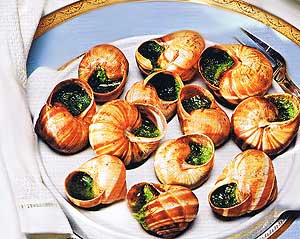 French cuisine helped to become popular
French cuisine helped to become popular 
